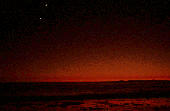|
|
|
1 | |||||||||||||||||||||||||||||
ASTRONOMY |
|||||||||||||||||||||||||||||

|
|||||||||||||||||||||||||||||
Confused about distances? |
|||||||||||||||||||||||||||||
|
Sound travels at 670mph or 1072kph. Light travels at 670 million mph or 1.1 billion kph. This also works out to be around 187,500 miles per second or 300,000 kilometres per second. If light at this speed travelled for one year, the distance would be around 9 460 350 000 000 kilometres, hence this amount is called simply 1 light year (l.y.). The parsec (pc) the other large distance unit is about 30 857 000 000 000 kilometres. 1 parsec = 3.26 l.y. The parsec is worked out by the distance at which a star would show a parallax of one second of arc. (trigonometry). It was first used in astronomy in 1832. |
|||||||||||||||||||||||||||||
|
| |||||||||||||||||||||||||||||
| FRONT PAGE | |||||||||||||||||||||||||||||
|
| |||||||||||||||||||||||||||||
| CONTENTS | |||||||||||||||||||||||||||||

|
|||||||||||||||||||||||||||||
Magnitudes |
|||||||||||||||||||||||||||||
| The further away an object is, the fainter it appears, obvious, and if it's bright, then you can see it even further! All the objects in the sky are a different brightness. This is called their apparent magnitude. The larger a telescope is, the higher the magnitude it can see. | |||||||||||||||||||||||||||||
| A rough guide to Magnitudes seen by different size telescopes: | |||||||||||||||||||||||||||||
Aperture (size) Magnitude |
|||||||||||||||||||||||||||||
50mm 10 60mm 10.5 70mm 11 90mm 11.5 114mm 12 150mm 13 200mm 13.5 254mm 14 406mm 15 Hubble space telescope 17 Camera film 18 World's largest telescope 23 CCD technology - so far 30 |
|||||||||||||||||||||||||||||
| The human eye can see to the 8th magnitude on the darkest of nights, when our eyes are dark adapted. | |||||||||||||||||||||||||||||
|
Apparent magnitudes of objects are as we see them from Earth. Absolute magnitude is the brightness of the objects seen as though they were 10 parsecs away. Absolute magnitude can be derived from apparent magnitude using the inverse square law for light. The distance to the object must also be determined. Once the relationship between brightness and distance is established stars can be calculated for their distance. |
|||||||||||||||||||||||||||||
|
|
|||||||||||||||||||||||||||||
| FRONT PAGE | |||||||||||||||||||||||||||||
|
|
|||||||||||||||||||||||||||||
| CONTENTS | |||||||||||||||||||||||||||||

|
|||||||||||||||||||||||||||||
| Contact Us - telescopes@bigpond.com | |||||||||||||||||||||||||||||